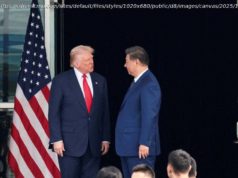A Chinese government campaign to cut leverage in the banking system and limit some risky…
By Shu Zhang and Matthew Miller
BEIJING, May 9 (Reuters) — A Chinese government campaign to cut leverage in the banking system and limit some risky activities appears to be working, but it is also pushing borrowers back towards alternative funding sources that carry similar risks to the financial system.
First-quarter official data shows banks cut the amount they lent to and borrowed from other financial institutions by 1.4 trillion yuan and 1.9 trillion yuan, respectively, to 21.7 trillion yuan and 30.3 trillion yuan. The growth in bank wealth management products (WMPs) , a key component of shadow banking credit, slowed to 19 percent year-on-year, down 35 percentage points.
Bankers said the slowdown came as the People’s Bank of China (PBOC) tightened liquidity conditions, which pushed up the cost of borrowing, and included off-balance-sheet WMPs in its macro-prudential assessment of banks’ risk levels for the first time.
As deleveraging accelerates, rates rise in the interbank market, and lenders´ interest margins are taking a hit. The yuan’s seven day repo rate, an indicator of market interest rates, has risen to its highest level since early 2015, according to Thomson Reuters data.
China’s central leadership has identified curtailing financial risks as a top priority this year after overall leverage rose sharply, and financial regulators have been instructed to keep on top of the task.
The China Banking Regulatory Commission (CBRC) has been targeting interbank activities and WMPs to determine whether banks are using those channels to disguise credit to loss-making «zombie firms» or businesses in restricted areas, such as real estate, according to an internal document dated March 28 and reviewed by Reuters.
CBRC also required banks to undertake self-assessments to report if their interbank liabilities exceeded a third of total liabilities, the document showed.
Lenders are under pressure to constrain the size of their interbank and WMPs business to avoid CBRC punishment, said an executive at a national bank’s interbank department.
It has stirred up a flurry of activity in banks eager to keep on the right side of the regulator, which handed out 190 million yuan in fines involving 485 investigations in the first quarter.
«We are holding meetings, learning the spirit of the regulations, preparing materials for self-assessment and regulatory reviews, » said a banker at a regional lender.
UNINTENDED CONSEQUENCES
Smaller banks tend to be more reliant on interbank activity and WMPs to grow their assets and profits, so they are likely to be most affected by the changes.
Industrial Bank Co, a mid-tier bank with large exposure to shadow banking and known in China’s financial community as «the king of the interbank», has already blamed «significantly increased» cost of interbank liabilities for a squeeze on its margins in the first quarter.
The bank shrank its interbank investment by 115.6 billion yuan and interbank liabilities by nearly 170 billion yuan, it said.
While such figures show government policies are changing behaviour, not all the changes will be welcome.
Central bank data shows that trust loans, entrusted loans and undiscounted banker’s acceptances, which are common forms of shadow banking activity in China, jumped more than 2 trillion yuan in the first quarter, more than four times the year-earlier increase.
«There are indications that regulatory measures to curb system-wide leverage show unintended consequences specifically, in reviving ‘core’ shadow banking activities that had previously been constrained by regulation, » said George Xu, Associate Analyst at Moody’s Investors Service.
Moody’s said borrowers in sectors such as property, local government financing vehicles and industries struggling with overcapacity faced reduced access to traditional bank loans and were being driven to trust loans.
Even as the crackdown began last year, a Reuters review of listed banks shows aggressive lenders like China Minsheng Bank and China Zheshang Bank continued to pile up loan-like assets categorised as asset management plans and trust beneficiary rights.
The CBRC has responded with a storm of at least eight new directives since late March.
The regulatory changes could further tighten domestic liquidity in the next six to 12 months, said Chen Long, China economist at Gavekal Dragonomics. That also posed short-term risks for domestic stock and bond markets, he said.
Shadow banking had grown so large after years of rampant growth, Chen said, that policymakers had to tread carefully in case over-strenuous attempts to rein it in caused a financial crisis.
«They cannot not regulate it, but they also cannot come down too hard on it, » he said. (Reporting By Shu Zhang and Matthew Miller; Editing by Will Waterman)






